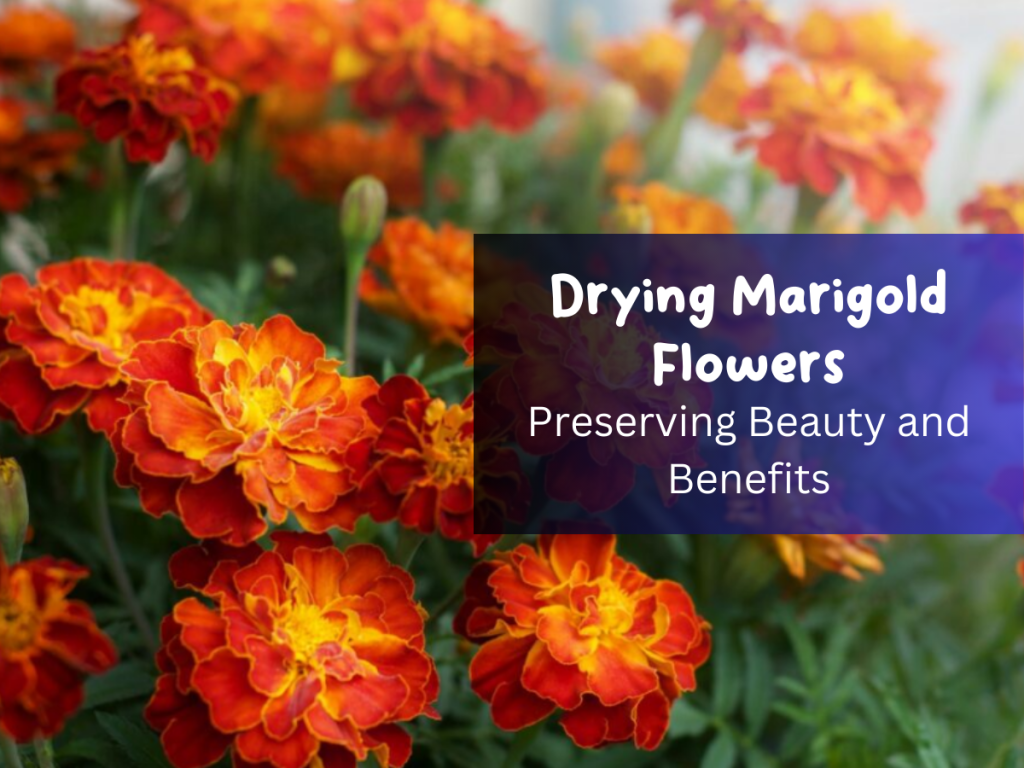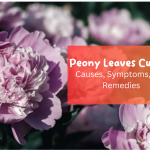Marigold flowers are beautiful, fragrant and have medicinal properties. Whether you have a garden full of marigolds or want to keep a unique bouquet, drying them is a great way to enjoy their beauty throughout the year. This guide will cover the different methods for drying marigold flowers and explain each step. Let’s get started!
Why dry marigold flowers?
There are several benefits to drying marigold flowers that make it a worthwhile endeavor. Let’s look at some of the key benefits:
Preserving Beauty:
Marigold flowers are known for their vibrant colors and enchanting beauty. Drying these flowers allows you to maintain their appearance and enjoy their splendor long after being withered. The dried flowers can be used for various crafts and decorative arrangements, adding a touch of natural elegance to your home or special occasions.
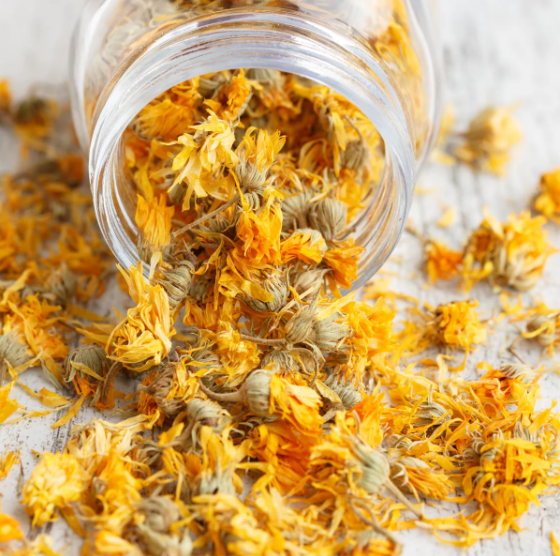
Extended Lifespan:
Fresh marigold flowers have a relatively short lifespan, but drying them can significantly extend their shelf life. Dried marigolds retain their color, shape, and scent for months or even years so that you can enjoy their beauty any time of the year.
Craft and be creative:
Dried marigold flowers are versatile and suitable for various creative projects. You can use them to make unique floral arrangements, wreaths, potpourri, or even handmade paper. Their bright colors and delicate texture make them ideal for adding a natural touch to various craft and DIY projects.
Therapeutic Uses:
Dried marigold flowers have long been recognized for their diverse medicinal properties. These flowers are a source of inspiration for herbal teas, oils, and remedies that possess anti-inflammatory, antiseptic, and antioxidant properties. Calendula-infused products are widely utilized to soothe skin irritation, promote healing, and address minor ailments.
Natural Dyes:
Did you know dried marigold flowers can be used as natural dyes? The petals contain luminous pigments that can be extracted to create beautiful and eco-friendly dyes for fabric, yarn, or other raw materials. This sustainable alternative to synthetic dyes allows you to create unique, earthy colors for your textile projects. Give it a try!
Fragrance and Aromatherapy:
Marigold flowers have a distinct and pleasant fragrance that can be preserved when dried. You can use dried marigold flowers to make potpourri or sachets to fill your surroundings with a delightful aroma. The scent of calendula is said to have a calming and uplifting effect, making it an excellent addition to aromatherapy.
Cheap:
Drying marigold flowers is an inexpensive way to enjoy their beauty and therapeutic benefits. Instead of buying dried marigold products, you can grow your marigold plants, harvest the flowers, and dry them at home. This way, you have a constant supply of dried marigold flowers without having to keep buying new ones.
Selecting and harvesting marigold flowers
To get the best results when drying marigold flowers, choosing the right flowers and harvesting them at the optimal time is vital. Choose marigold flowers that are fully open but not yet wilting. The petals should be vibrant and firm with no signs of rot or damage.
Harvest the marigold flowers early in the morning, after the dew has dried but before the sun gets too intense. Use sharp pruning shears or scissors to cut off the stems of the flowers just above the leaves. Harvesting at this point ensures that the buds have maximum essential oil content and vibrant colors.
Air-dry marigold blossoms
Air drying is the most common and easiest way to dry marigold flowers. Here is a step-by-step guide:
- Gather a bouquet of marigold flowers and tie the stems with a rubber band or string. Make sure the fragrance is small enough for air to circulate.
- Hang the marigold bouquet upside down in a cool, dark, well-ventilated place; this can be a closet, an attic, or any other convenient area. Hanging the flowers upside down will help them keep their shape and prevent the petals from drooping.
- Let the flowers dry completely. Depending on the conditions, this can take one to three weeks. Ensure adequate air circulation to prevent mold growth.
- Once the marigold petals have dried, gently detach the petals from the stems. Gently separate the petals from the flower heads and discard any damaged or discolored petals.
- Store the dried marigold flowers in an airtight container away from direct sunlight to keep their color and scent.
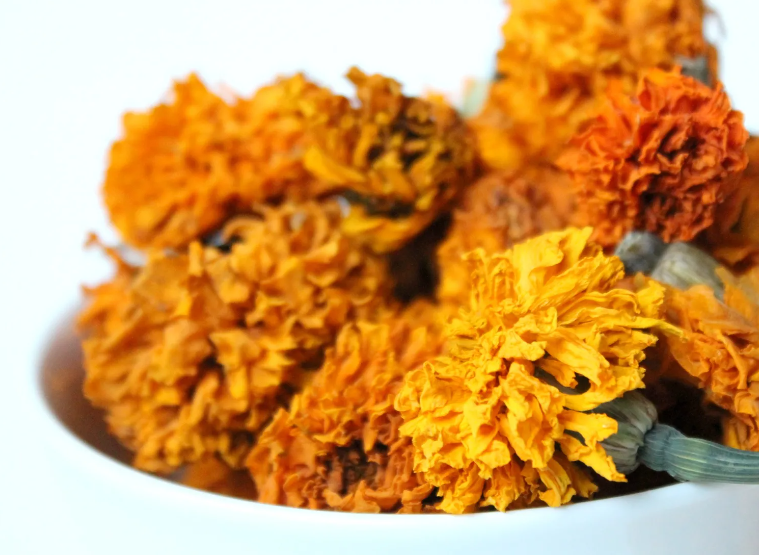
Using a dehydrator
A food dehydrator is an excellent option if you prefer a faster and more controlled drying method. That’s how it works:
- Prepare the marigold flowers by removing excess leaves and cutting off the stems. Be sure to handle them gently so as not to damage the petals.
- Place the buds in a single layer on the dehydrating trays, ensuring they do not overlap. A space between the petals provides better air circulation and even drying.
- Set the dryer to a low temperature of about 35°C (95°F) and let it run for several hours. Check the flowers regularly to avoid over-drying. Drying time may vary depending on the dehydrator and the moisture content of the flowers.
- Once the flowers are crisp and dry, remove them from the dehydrator and allow them to cool completely before storing them in airtight containers—label and date containers to track drying time and preserve freshness.
Tips for a successful drying
- Avoid drying marigold flowers in direct sunlight, as this can cause the colors to fade. Choose an excellent dark spot to preserve the vibrancy of the petals.
- Ensure good air circulation during drying to avoid mold growth; This is especially important if you air-dry the flowers.
- Label and date containers to track drying time and preserve freshness. Proper labeling will help you identify and use the dried marigold flowers appropriately.
- Handle dried calendula flowers gently to avoid breaking them. They are delicate and can easily crumble if not handled properly.
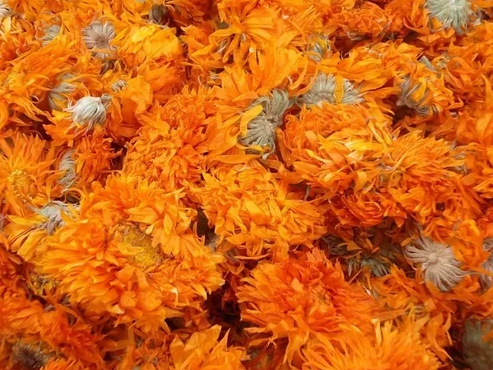
Conclusion
Drying marigold flowers is a rewarding and practical way to prolong their beauty and harness their beneficial properties. Whether you choose the traditional method of air drying or opt for a dryer, these techniques will allow you to enjoy the bright colors, pleasant fragrance, and therapeutic benefits of marigold flowers all year round. So get creative and explore the endless possibilities that dried marigold flowers offer! With the proper care and attention to detail, you can master the art of drying marigold flowers and creating beautiful, long-lasting creations. Read more article like this in our category need to post, thank you for visiting Avi Hoffman.
FAQs about Drying Marigold Flowers:
A: Properly dried and stored, dried marigold petals can last for several months to a year, retaining their color, fragrance, and therapeutic properties.
A: Dried marigold flowers have versatile uses. They are commonly used in crafts such as wreaths, potpourri, and floral arrangements. They are also employed in herbal remedies, teas, natural dyes, and aromatherapy products.
A: Dried marigold petals can be used for various purposes. They can be added to herbal teas for their flavor and medicinal properties. They are also used in homemade skincare products, bath salts, and infused oils. Additionally, they serve as a natural dye source for fabrics and yarns.

